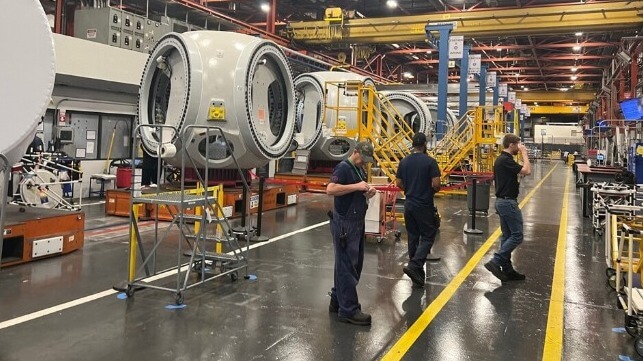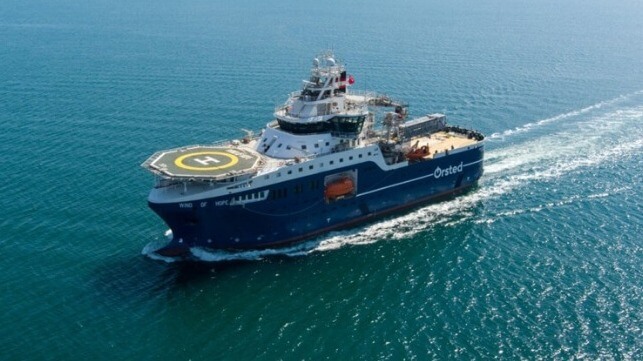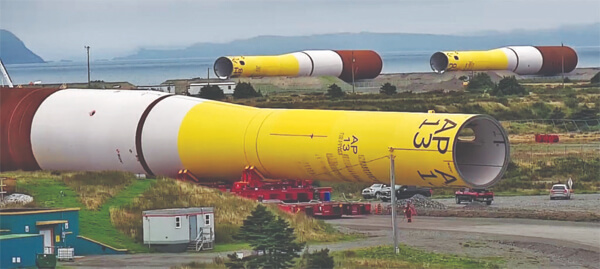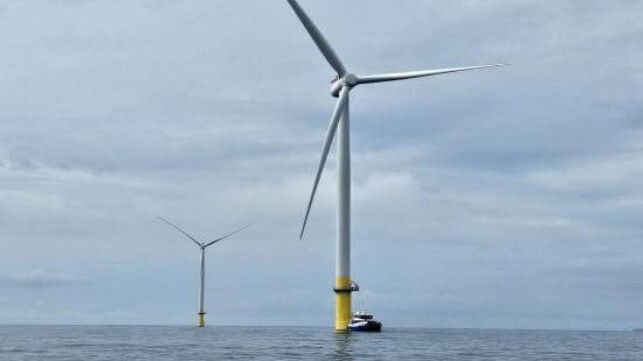GE Vernova Plans to Pull Back on Wind Power Including Large Job Cuts

In a potentially critical blow to the development of the wind energy sector, GE Vernova, one of three leading manufacturers of wind turbines, confirmed it is looking at scaling back this portion of its business. The company’s plan would leave only two large Western manufacturers as well as the emerging competition from Chinese companies.
The company confirmed reports that it has made a filing with its European Works Council, which would be the first step toward layoffs for its operations in France. EU labor regulations require the company to notify and involve its unions in any planned reorganization.
The company said it is looking at what it called a “downsizing to transform its offshore business globally into a small, learner, and more profitable business.” The reports say it could involve cutting as many as 900 jobs with a third or more of the cuts reportedly planned for the company’s two facilities in France. The plant in Montoir-de-Bertange which builds nacelles according to reports in the French media could lose more than half its workforce. A second facility in Nantes could be downsized by a third. In total, the reports in France say the company is seeking to cut as many as 360 people.
By management’s own emissions, 2024 has been “a very difficult year” for the wind power segment of the company which was spun out from GE in April 2024 to focus on power, wind, and electrification. Earlier this year the company reported it had decided to shelve a plan to build an 18 MW version of its Haliade-X offshore wind turbines. It said it would instead focus on its 13 and 15 MW units which were called the workhorse of the industry. The retrenchment was cited as the reason New York State canceled three selected projects that planned to use the larger turbines.
The company also suffered a high-profile incident when one of the blades on its turbine at the Vineyard Wind 1 project in Massachusetts fractured sending bits into the ocean. The debris washed up on local beaches leading to more protests over the safety of offshore wind power. GE Vernova later blamed that failure on a manufacturing deviation at its plan in Quebec, Canada. All the blades were being reinspected.
Two failures of blades at the UK’s Dogger Bank wind farm were also for its Haliade turbines. They were blamed on installation problems.
The failures along with disruptions in the supply chain and higher material costs due to inflation were cited as placing increased pressure on this segment of the company’s business. The supply contracts also have long lead times exposing the company to increased costs. In September, GE Vernova told investors its wind segment is now expected to generate an approximately $300 million EBITDA loss in the third quarter of 2024 given these costs, despite onshore wind delivering a fifth straight quarter of profitability. The company said it expects the wind segment to be modestly profitable in the fourth quarter.
GE Vernova’s scaling back leaves Siemens Gamesa and Vestas Wind Systems as the two leading Western manufacturers. China’s Mingyang and others are growing competitors seeking to make inroads into the Western market. News however that an offshore wind farm in Germany planned to use Mingyang as its supplier triggered a host of political complaints and reports that the contract would be placed under tight scrutiny.
At the beginning of September, an offshore project planned for New Jersey known as Leading Light Wind asked regulators for a delay citing supply chain problems. The company said it was having problems securing a provider of turbines after GE Vernova canceled its larger turbines. According to the reports, the New Jersey developer decided not to use Vestas while Siemens Gamesa reportedly told them there would be a significant price increase for the turbines.
GE Vernova in its September update to investors cited incremental strength in its Power and Electrification segments saying that it gave it the confidence to reaffirm its full-year 2024 financial guidance despite the challenges in its Wind segment. The company’s stock price was flat today while it was up nearly eight percent for the week. Since the spinoff from GE in April, the stock price is up more than 87 percent.
SOV Servicing UK's Hornsea Wind Farm Hits and Damages Wind Turbine

One of the modern Service Operations Vessels designed specifically to service offshore wind farms was involved in an incident yesterday, September 19. There were no injuries to the crew and technicians aboard but the vessel struck one of the turbines resulting in damage to both the vessel and the base of the turbine.
The SOV is the Wind of Hope, the second of two SOVs built for French company Louis Dreyfus Armateurs (LDA) by the Cemre Shipyard in Turkey. The vessel is 6,500 gross tons and has a length of 275 feet (84 meters) with accommodations for 90 people. The ship was delivered in July 2021 and like the new generation vessels of the class, has dynamic positioning and safety features including a walk-to-work telescopic motion compensated gangway.
Few details were provided, but according to LDA, the vessel allided with one of the turbines at 1838 last evening in daylight. The contact caused damage to the starboard side of the vessel above the waterline and the helideck. There was also some damage to the base of the turbine.
The Wind of Hope is operating under charter to Ørsted for the Hornsea offshore wind farm located approximately 75 miles east of Hull and Grimsby, UK in the North Sea. Hornsea 1 has been in operation since 2020 with 174 turbines and is part of the largest offshore wind complex which will ultimately consist of four sections.
The vessel shows that it had departed the base in Grimsby on September 17. LDA reports there are 26 crew members and 46 specialist personnel on board, none of whom were injured. There was no water ingress, nor pollution reported. The vessel is on its way back to Grimsby for a full assessment of the damage.
Ørsted is reported to have created an exclusion zone around the turbine involved in the incident.
Canadian Port Grows as Staging Point for U.S. Offshore Wind

The Port Argentia in the eastern reaches of Canada’s Newfoundland is using its strategic position and available land to develop a business in staging for U.S. offshore wind farms. Port officials reported they have signed a contract with Denmark’s Scan Global Logistics which is responsible for transporting the wind turbine blades which will be staged in 2024 and 2025 before installation.
“Capitalizing on our place as North America’s first monopile marshaling port, we’re now positioned to further expand our capabilities by securing a contract to store and marshal 220 offshore wind turbine blades,” said Scott Penney, CEO of Port of Argentia. “The addition of wind turbine blades demonstrates our unique storage capacity and adds to our portfolio of offshore wind projects.”
The arrangement with Scan Global Logistics, a global transportation and logistics, will see 220 wind turbine blades arrive via heavy transport vessels at Argentia, beginning this fall and continuing into 2025. The port has entered into a lease and services agreement for marshaling and security services utilizing a 12-hectare bonded yard at Argentia.
Ultimately, vessels will pick up the large constructions and deliver the blades for installation at wind farms off the Eastern Seaboard of the U.S. The name of the project is not revealed due to the sensitive nature of the project which skirts the U.S. Jones Act requirements and demands from U.S. states for the use of union labor and local ports.
The blades, however, are massive measuring several hundred feet and requiring large storage spaces. It is perfect for the Port of Argentia, which was formerly the site of a U.S. naval base in southeastern Newfoundland. Argentia is being redeveloped into a heavy industrial seaport and seeking opportunities with marine transportation, renewable energy, aquaculture, offshore oil, and mining.

Boskalis vessels began delivering monopiles in 2023 (Argentia)
Utilizing its existing infrastructure and vast land assets, the port is making available over 70 hectares of paved runways from the former U.S. naval station, within 6,500 feet of quayside, for the marshaling operation. The first operation began in August 2023, with the arrival of Boskalis’ heavy lift vessels transporting monopiles. The port said it was scheduled to receive and store up to 120 monopiles which would be used for future installation in the U.S.
In 2024, the port also entered into initial agreements with the Port of Hamburg (Germany) as part of the effort to develop a future green hydrogen export business. The governments of Germany and Canada supported the project which calls for the production of green hydrogen in Newfound that would be shipped to Germany as an energy source.

Monopiles marshaled at Argentia starting in August 2023 (Argentia)
Gulf of Maine Wind Auction Scheduled as Tribes Seek to Delay Oregon Sale

The Biden administration continues to move forward aggressively to realize its plans for offshore wind energy generation scheduling the second auction planned for October 2024. The Department of the Interior set October 29 for the first auction of Gulf of Maine areas which would be just two weeks after the scheduled sale on the Oregon coast. A collation of tribes however is trying to delay the Oregon sale.
The Department of the Interior highlights it has conducted five offshore wind lease sales during the Biden administration. This includes the record-setting New York Bight as well as the Central Atlantic, the California coast, and less well-received sales in the Gulf of Mexico. A total of 10 offshore wind farms have won approval with the Bureau of Ocean Energy Management (BOEM) recently highlighting the U.S. had reached approval for more than 15 GW offshore wind energy capacity, halfway to the initial offshore goal.
The planned sale for the Gulf of Maine would be a critical step as it has the potential for approximately 13 GW of offshore wind energy capacity. The eight areas are on the Outer Continental Shelf off Massachusetts, New Hampshire, and Maine. BOEM highlights it shaved off another 120,000 acres from the original proposal reflecting input from the community of ocean users. The final call area outlined in April 2024 was nearly 10 million acres.
“The upcoming Gulf of Maine offshore wind energy auction reflects our all-of-government approach for reaching the Biden-Harris Administration’s energy goals while combatting the climate crisis,” said BOEM Director Elizabeth Klein. BOEM is moving forward quickly, having just reported on September 8 that it had completed the environmental review for the area.
The Gulf of Maine sale will come just two weeks after the scheduled first offshore sale for the coast of Oregon. BOEM announced at the end of August plans to offer three areas ranging from Coos Bay to Brandon and Brookings, which will total nearly 200,000 acres. They calculate the potential for 3.1 GW of energy from the sites.
The Oregon sale has faced persistent opposition from the communities that argue BOEM is moving too quickly. Oregon as a state is not expected to complete its road map for offshore wind development till 2025.
The Confederated Tribes of the Coos, Lower Umpqua, and Siuslaw Indians filed a lawsuit on September 13 against BOEM seeking to delay the sale.
“The intent of this lawsuit is to stop the October lease sale and force BOEM to do a comprehensive Environmental Impact Statement that honestly looks at the impact that wind energy will have on Coastal resources,” said Tribal Council Chair Brad Kneaper. “Coastal Tribes have repeatedly met with BOEM urging BOEM to take its time to develop wind energy in a way that does not adversely impact Tribes and the resources which they depend upon.”
As part of its five-year strategy, BOEM previously released a schedule for 12 additional offshore wind auctions by 2028. However, at the end of July, BOEM reported it was canceling a planned sale for the Gulf of Mexico. They cited low interest instead proposing moving to an agreement with the sole company that was pursuing the leases.
The Department of the Interior cites the extensive review process used to plan sales. For the Gulf of Maine, they said there were two years of engagement with the information used to shape the Final Sale Notice, which will be published on September 17 in the Federal Register.